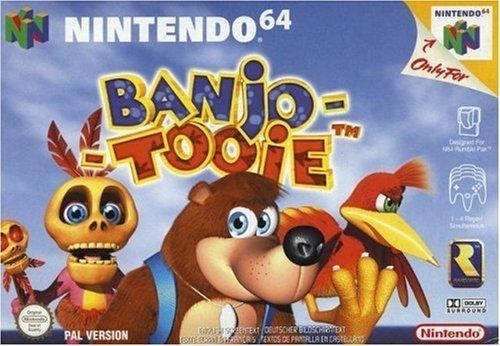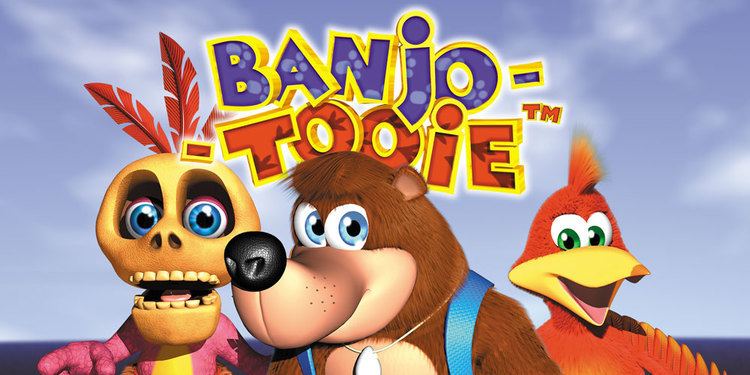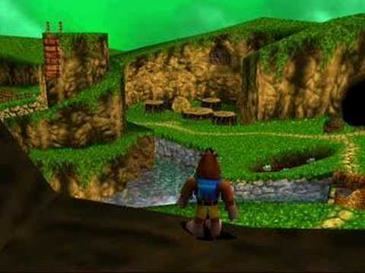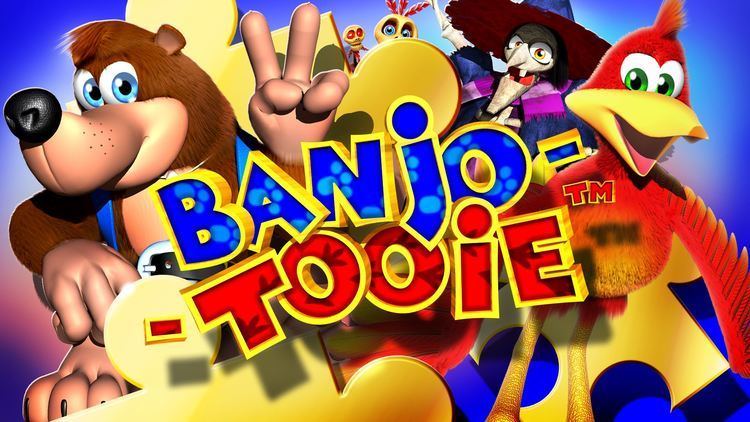9.4 /10 1 Votes9.4
4.6/5 Emuparadise Programmer(s) Chris Sutherland | 9.4/10 IGN 4.8/5 eBay Artist(s) Steve Mayles Initial release date 20 November 2000 | |||||||||||||||||||||||||||||||||
 | ||||||||||||||||||||||||||||||||||
Release date(s) Nintendo 64NA: 20 November 2000EU: 12 April 2001Xbox 360WW: 29 April 2009 Similar Banjo-Kazooie games, Rare games, Platform games | ||||||||||||||||||||||||||||||||||
Full play banjo tooie part 1
Banjo-Tooie is a platform video game developed by Rare and published by Nintendo for the Nintendo 64. It was first released on 20 November 2000 in North America and on 12 April 2001 in Europe, and later re-released as an Xbox Live Arcade game for the Xbox 360 on 29 April 2009. It is the second instalment in the Banjo-Kazooie series and serves as a sequel to the original Banjo-Kazooie. The story of the game follows series protagonists Banjo and Kazooie as they attempt to stop the plans of antagonist Gruntilda and her two sisters from vapourising the inhabitants of the game's world.
Contents

Development of the game started in June 1998, directly after the release of its predecessor. Several new features were cut from the game due to time constraints and limitations of the Nintendo 64 hardware. Banjo-Tooie features levels that are significantly larger than those of its predecessor and requires the player to complete various challenges such as solving puzzles, collecting items, and defeating bosses. It also includes a multiplayer mode where up to four players can compete in several minigames. Upon release, the game sold more than three million copies and received critical acclaim from video game critics. The game is also included in the Rare Replay video game compilation, released for the Xbox One in 2015.

Gameplay

Similar to its predecessor Banjo-Kazooie, Banjo-Tooie features three-dimensional worlds containing items to be collected. Among the items are golden jigsaw pieces, called Jiggies, that are used to complete jigsaw puzzles that unlock the levels. Instead of exploring the hub world in search of incomplete puzzle boards as in Banjo-Kazooie, a singular board is used within a temple where Master Jiggywiggy resides. Whenever the player has obtained the number of Jiggies required, a timed puzzle-completion challenge can be played, after which Jiggywiggy grants access to each world. Each puzzle challenge requires more Jiggies than the last.
Musical notes return in Banjo-Tooie, but are now used to learn new moves from Bottles' brother, the drill sergeant Jamjars, who assumes Bottles' role from the first game. All of Banjo and Kazooie's moves from the first game are immediately accessible in Banjo-Tooie, and the player can acquire several new moves such as first-person aiming, new egg types, and the ability to play as Banjo and Kazooie separately, with each gaining moves they can only use while on their own. Mumbo Jumbo also returns, this time as a playable character who can venture out into each world and use specific magic spells to help Banjo and Kazooie proceed. Taking over Mumbo's previous role of transforming the duo into different forms is Humba Wumba, a Native American woman who acts as Mumbo's rival.
Another feature introduced in Banjo-Tooie is the direct connections between its worlds. In Banjo-Kazooie the titular duo would be transported to each level via special doors in Gruntilda's lair, but in Banjo-Tooie the levels are physically connected at multiple points and are effectively extensions of the Isle o' Hags hub world. In addition, the train Chuffy can be used to migrate minor characters between worlds which contain stations. The game also includes a multiplayer mode where up to four players can play each of the game's single-player minigames in customisable competitions.
Plot
Two years following Gruntilda's first defeat by Banjo and Kazooie, the two are playing poker with their friends Mumbo Jumbo and Bottles in Banjo's house. Meanwhile, Gruntilda's sisters Mingella and Blobbelda arrive in a large digging machine, the Hag 1, and destroy the boulder trapping Gruntilda with a magical spell. Unfortunately Gruntilda's time spent underground has rotted her flesh away and reduced her to a skeleton. Seeking revenge, Gruntilda destroys Banjo's house before fleeing with her sisters. Banjo, Kazooie, and Mumbo escape the house, but Bottles, who stays behind believing it is all a joke, gets caught in the blast and is killed. The three remaining friends swear to track Gruntilda down and put an end to her plans.
Following the witches' trail, Banjo and Kazooie arrive at Jinjo Village on the Isle o' Hags, where King Jingaling, king of all the Jinjos, explains that his subjects were frightened away by the Hag 1 and scattered throughout the island. He gives the two their first Jiggy as a token of gratitude to help find them. Meanwhile, Gruntilda's sisters introduce her to a cannon called the "Big-O-Blaster" (B.O.B.) that can suck the life force from any given target. They test B.O.B. on King Jingaling, who consequently is turned into a zombie. Gruntilda plans to charge B.O.B. long enough to blast the entire island and use the stolen life force to restore her body. The witch's most loyal minion, Klungo, is sent out to hinder Banjo and Kazooie in their progress by fighting them, but after taking many beatings from Gruntilda as punishment for losing to them, Klungo eventually abandons her and sides with Banjo and Kazooie.
Finally reaching Gruntilda's fortress at Cauldron Keep, Banjo and Kazooie confront the witch and her sisters in a trivia quiz show named the Tower of Tragedy Quiz in which losing competitors will be flattened under one-tonne weights. Mingella and Blobbelda lose to Banjo and Kazooie, getting crushed, but Gruntilda escapes. Banjo and Kazooie then reverse the effects of B.O.B., resurrecting both King Jingaling and Bottles, who celebrate at Bottles' house along with Klungo. Banjo and Kazooie enter the top of the fortress and defeat Gruntilda, destroying most of her body and the Hag 1 along with her. The two return to Bottles' house with their remaining friends (Jamjars, Mumbo, and Wumba) to find that everyone else has celebrated without them, much to their disappointment. They instead head to Cauldron Keep and play a game of hacky-sack with Gruntilda's head, who vows to have her revenge.
Development
Banjo-Tooie was developed by Rare and designed by Gregg Mayles, who previously worked on Banjo-Kazooie. Development of the game started in June 1998. Some features that were originally cut during the development of Banjo-Kazooie, such as some of its worlds and a multiplayer game mode, were instead integrated into Banjo-Tooie. An additional world set in a castle was planned, but due to time constraints, it was scrapped during development and assets from it were used in constructing Cauldron Keep. The game features roughly 150 total characters, including enemies and non-playable characters.
Originally, Rare planned to include an additional mode, called Bottles' Revenge, where a second player could play as an undead version of Bottles and take control of enemy characters to hinder Banjo in his quest, with the players swapping roles if the enemy character managed to defeat Banjo. The idea was ultimately scrapped because the developers ran out of time to debug it, despite admitting that "it did work rather well". However, it would later serve as the inspiration behind the "Counter Operative" multiplayer mode in Perfect Dark. Bosses were originally to be able to be controllable by the second player as well, but the only boss that the developers had working when they dropped the mode was the third boss, 'Old King Coal'. The developers also planned to implement a feature, called "Stop 'N' Swop", that would have allowed data to be transferred from Banjo-Kazooie to Banjo-Tooie so that players could unlock additional bonuses in Banjo-Tooie. However, due to hardware limitations of the Nintendo 64 system, the feature was ultimately dropped. It is, however, included in the Xbox Live re-release. Despite this, Rare decided to include at least some of the additional bonuses within the game.
The music was composed by Grant Kirkhope, who previously worked as the main composer for Perfect Dark, Donkey Kong 64, and Banjo-Kazooie. As Banjo-Tooie was a larger game than its predecessor, Kirkhope had twice the memory space in the game's cartridge for sound effects and music. Kirkhope initially had to pause his work on Banjo-Tooie to work on other projects first, but ultimately the music score for the game was completed on time. Like the original, the themes heard in the game were designed to be interactive, which dynamically change to reflect the player's location. Due to the game having larger memory space Kirkhope was able to combine two MIDI files to channel different fades of music when the player moves to different locations. The developers initially aimed for a fourth quarter 1999 release, but the game was ultimately delayed. Banjo-Tooie was presented at the 2000 Electronic Entertainment Expo and released on 20 November 2000. The game supports the Nintendo 64 Rumble Pak.
Reception
Upon release, Banjo-Tooie was critically acclaimed and sold more than three million copies worldwide. Johnny Liu of Game Revolution considered Banjo-Tooie to be less repetitive than Donkey Kong 64 and a worthy successor to Banjo-Kazooie. Nintendo Power referred to Banjo-Tooie as "the perfect cross between Donkey Kong 64 and Banjo-Kazooie", noting that it features less backtracking between levels than Donkey Kong 64 does. The publication also stated that the only disappointment was how Rare resolved the "Stop 'N' Swop" bonuses. Mark Green of N64 Magazine felt that, although Banjo-Tooie delivers "a decent complement of clever puzzles and enjoyable run-and-jump moments", it did not feel "as fresh or as exciting" as previous Rare platformers.
The graphics were considered some of the best on the Nintendo 64 due to their rich textures, long drawing distance, and real-time shadow generation, but were criticised for their inconsistent frame rate during certain points in the game. Nevertheless, GameSpot noted that the action level of the game was normally low enough that it "does not significantly distract from the experience". Game Revolution said that the game was "beautiful", but it did not meet the same level of awe as its predecessor. The game was also praised for its humour, with Edge commenting that its characters are "impossible to dislike."
The gameplay was highlighted for the size of the game's worlds. Jes Bickham of GamesRadar described Banjo-Tooie as a game that requires a massive time-investment on the player's part, saying that "Keeping track of what you can do next, or where you can re-visit to get something new, requires either a photographic memory or copious note-taking". Similarly, GamePro remarked that the game is so large that players might lose their way and forget what they are supposed to do. GameSpot's Shane Satterfield praised the game's level design and progression for constantly requiring players to collect Jiggies. Despite the praise, Edge concluded that Rare should have innovated more instead of simply copying the formula of Super Mario 64. At the 2000 GameSpot Game of the Year awards, Banjo-Tooie was awarded Best Platform Game.
Re-releases
An Xbox Live Arcade version of Banjo-Tooie, developed by 4J Studios, was released for the Xbox 360 on 29 April 2009. This version features a smoother frame rate and high-definition graphics, and supports the "Stop 'N' Swop" connectivity with the Xbox Live Arcade version of its predecessor, allowing players to unlock the bonuses included in the original Nintendo 64 version as well as new content related to the Xbox 360. The Xbox Live Arcade version of Banjo-Tooie received mixed to favourable reviews from video game critics, featuring an aggregate score of 73 out of 100 at Metacritic. In 2015, the Xbox Live Arcade version of the game was included as part of the Rare Replay video game compilation for Xbox One.
